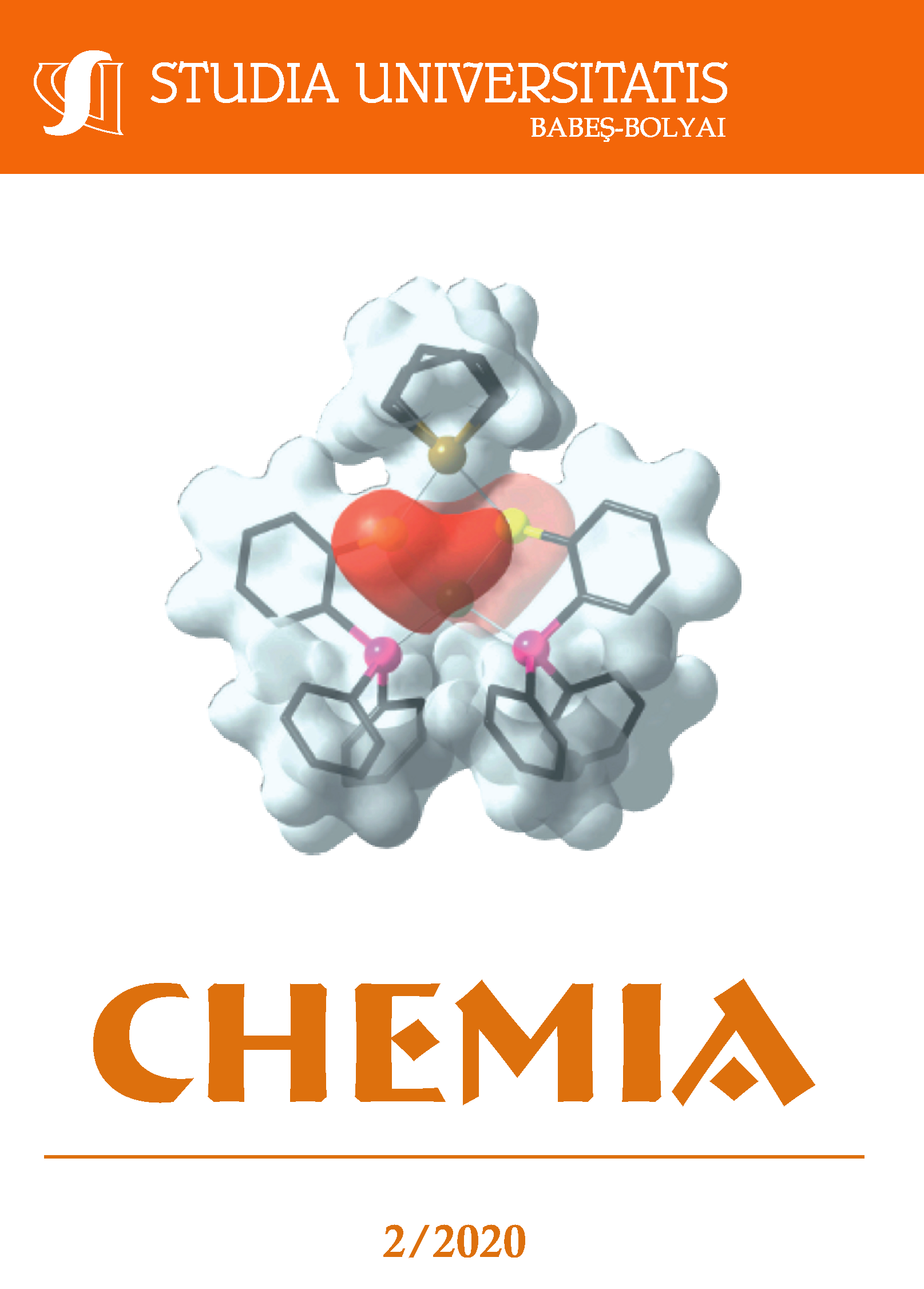ELEMENTAL ANALYSIS OF CULINARY HERBS AND SPICES BY ICP OES: CLASSIFICATION BY CHEMOMETRICS
DOI:
https://doi.org/10.24193/subbchem.2020.2.06Keywords:
culinary herbs, spices, macro and microelements, ICP OES, chemometrics, classificationAbstract
The inductively coupled plasma optical emission spectrometry method (ICP OES) was optimized and validated for the quantification of 21 elements in 88 samples of 23 types of culinary herbs and spices. All analyzed samples were low in Na, but rich in Ca, K and P. Among the microelements, the most abundant was Fe, followed by Cu, Zn, Cr, and Se. The concentrations of toxic elements (Cd and Pb) were below the permissible limits given by the World Health Organisation (WHO). Chemometrics was performed by the principal component analysis (PCA) and cluster analysis (CA). PCA generated two principal components that explained 43.82% of the total variance in the data and all samples were classified into six groups based on the element content. Also, PCA and CA allowed the differentiation and classification of culinary herbs and spices based on the concentration of five major elements.
References
The United Nations Industrial Development Organization and Food and Agriculture Organization (UNIDO/FAO), “Spices and essential oils: Post-harvest operations indeveloping countries”, 2005. Available from: http://www.fao.org/3/a-ad420e.pdf.
R. Naveed, I. Hussain, A. Tawab, M. Tariq, M. Rahman, S. Hameed, S. Mahmood, A.B. Siddique, M. Iqbal, BMC Complem. Altern. M., 2013, 13(1), 265.
A.H. El-Ghorab, M. Nauman, F.M. Anjum, S. Hussain, M. Nadeem, J. Agric. Food Chem., 2010, 58(14), 8231-8237.
L. Hernández-Ochoa, Y.B. Aguirre-Prieto, G.V. Nevárez-Moorillón, N. Gutierrez-Mendez, E. Salas-Muñoz, J. Food Sci. Technol., 2014, 51(5), 957-963.
N. Celikel, G. Kavas, Czech J. Food Sci., 2008, 26(3),174-181.
B. Sgorbini, C. Bicchi, C. Cagliero, C. Cordero, E. Liberto, P. Rubiolo, J. Chromatography, 2015, 1376, 9-17.
M.A. Paleari, V.M. Moretti, C. Bersani, G. Beretta, T. Mentasti, Meat Sci., 2004, 67(4), 549-557.
N. Khan, J.Y. Choi, E.Y. Nho, N. Jamila, G. Habte, J.H. Hong, I.M. Hwang, K.S. Kim, Food Chem., 2014, 158, 200-206.
M.E. Ghanjaoui, M.L. Cervera, M. El Rhazi, M. de la Guardia, Food Chem., 2011, 125,1309-1313.
M. Tahri, B. Imelouane, F. Aouinti, H. Amhamdi, A. Elbachiri, Res. Chem. Intermed., 2014, 40, 2651-2658.
M. Özcan, M. Akbulut, Food Chem., 2007, 107(2), 852-858.
S. Kumaravel, K. Alagusundaram, Orient. J. Chem., 2014, 30(2), 631-636.
A.A.K. Abou-Arab, M.A. Abou Donia, J. Agric. Food Chem., 2000, 48(6), 2300-2304.
J.M. Mermet, Anal. Chim. Acta, 1991, 250, 85-94.
M. Mitić, A. Pavlović, S. Tošić, P. Mašković, D. Kostić, S. Mitić, G. Kocić, J. Mašković, Microchem. J., 2018, 141, 197-203.
J.M. Mrmošanin, A.N. Pavlović, J.N. Krstić, S.S. Mitić, S.B. Tošić, M.B. Stojković, R.J. Micić, M.S. Đorđević, J. Food Compost. Anal., 2018, 67, 163-171.
W. Horwitz, Anal. Chem., 1982, 54, 67-76.
M. Thompson, The amazing Horwitz function. AMC Technical Brief No.17., London, UK: Royal Society of Chemistry, 2004. Available from: https://www.rsc.org/images/horwitz-function-technical-brief-17_tcm18-214859.pdf.
A.G. Gonzalez, M.A. Herrador, Trend. Anal. Chem., 2007, 26(3), 227.
Method Validation Program (OMA/PVM Department), including Appemdix D: Guidelines for collaborative study procedures to validate characteristics of a method of analysis, Rockville, MD, USA: AOAC International, 2000, Available from: http://www.aoac.org/aoac_prod_imis/AOAC_Docs/StandardsDevelopment/Collaborative_StudyValidation_Guidelines.pdf.
Ş. Tokalioğlu, Food Chem., 2012,134(4), 2504-2508.
N.K. Aras, O.Y. Ataman, “Trace element analysis of food and diet”, RSC Food Anal Monographs, Cambridge, United Kingdom, The Royal Society of Chemistry, 2006.
World Health Organization (WHO), “Boron”, Environmental Health Criteria 204: International programme on chemical safety [online]. Geneva, Switzerland, 1998. Available from: http://www.inchem.org/documents/ehc/ehc/ehc204.htm/.
World Health Organization (WHO), “Barium and barium compounds”, Concise International Chemical Assessment Document 33 [online]. Geneva, Switzerland, 2001. Available from: https://apps.who.int/iris/bitstream/handle/10665/42398/9241530332.pdf?sequence=1/.
M. Brokbartold, M. Wischermann, B. Marschner, Water Air Soil Pollut., 2011, 223(1), 199-213.
D.K. Gupta, F.J. Corpas, J.M. Palma, “Heavy metal stress in plants”. Springer-Verlag, Berlin Heidelberg, Germany, 2013.
Food and Agriculture Organization and World Health Organization (FAO/WHO), “Trace elements in human nutrition and health”, International Atomic Energy & Food and Agriculture Organization of the United Nations Geneva, Geneva, Switzetland, 1996. Available from: https://www.who.int/nutrition/publications/micronutrients/9241561734/en/.
J. Cohen, “Statistical power analysis for the behavioral science” 2nd edition, Lawrence Erlbaum Associates, New York, 1988.
T.W. Anderson, “An introduction to multivariate statistical analysis” 3rd edition, John Wiley and Sons, Hoboken, New Jersey, 2003.
H.F. Kaiser, Educ. Psychol. Meas., 1960, 20, 141-151.
S.R. Imadim, S. Wasee, A.G. Kazi, M.M. Azooz, P. Ahmad, “Aluminum toxicity in plants” An overview. In: Ahmad, P. (Ed.): Plant metal interactions, 1st edition, Elsevier Inc, Amsterdam, 2016, pp. 1–20.
R. Hajiboland, S. Bahrami-Rad, J. Barcelo, C. Poschenrieder, J. Plant Nutr. Soil Sc., 2013, 176, 616-625.
A. Azizi, F. Yan, B. Honermeier, Ind. Crops Prod., 2009, 29(2/3), 554-561.
R. Reeves, NATO Science Series IV: Earth Environmental Sciences, 2006, 68, 25.
J.L. Todoli, L. Gras, V. Hernandis, J. Mora, J. Anal. Atomic Spectrom., 2002, 17(2),142-169.
M.L. Salit, G.C. Turk, A.P. Lindstrum, T.A. Butler, C.M. Beck, B. Norman, Anal. Chem., 2001, 73(20), 4821-4829.
K.E. Sharpless, J.B. Thomas, S.J. Christopher, R.R. Greenberg, L.C. Sander, M.M. Schantz, M.J. Welch, S.A. Wise, Anal. Bioanal. Chem., 2007, 389(1),171-178.
I.T. Jolliffe, J. Cadima, Philos. T.R. Soc. A, 2016, 374:20150202.
F. Zolfaghari, H. Khosravi, A. Shahriyari, M. Jabbari, A. Abolhasani, PLoS one, 2019, 14(12), e0226355.
Downloads
Published
How to Cite
Issue
Section
License
Copyright (c) 2020 Studia Universitatis Babeș-Bolyai Chemia

This work is licensed under a Creative Commons Attribution-NonCommercial-NoDerivatives 4.0 International License.



